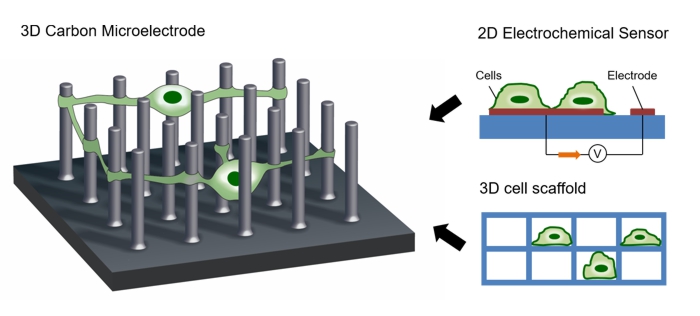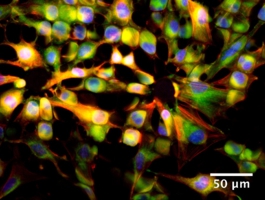In bioelectrochemistry, cells are typically incubated on 2D electrodes. The
major limitation of this approach is that planar electrode geometry poorly
mimics the natural environment of the cells. In parallel, 3D scaffolds
have been developed to provide a more realistic environment for the cells but
these structures usually lack integrated sensor functionality to perform in situ measurement on the 3D cell
culture. We address these limitations by
the development of “smart” cell scaffolds as a powerful new tools for
the measurement of cell response to external stimuli such as drug or environmental pollutants. This scaffold consists of 3D
carbon microelectrodes, providing both a 3D environment for cellular growth as
well as the possibility for 3D electroanalysis in the 3D cell culture. The fabrication of the scaffolds is achieved using SU-8 photolithography and pyrolysis. At present, we work on the integration of 3D carbon scaffolds on microelectrode chips. The 3D cell scaffolds have been applied for monitoring of human neural stem cells and Saos-2 osteosarcoma cells.




Left/center: Human neural stem cells on pyrolytic carbon micropillars; right: Saos-2 cells on suspended carbon grids
Publications
- L. Amato, A. Heiskanen, C. Caviglia, F. Shah, K. Zór, M. Skolimowski, M. Madou, E.G. Seiz, M. Ramos, T.R. Moreno, A. Martinez-Serrano, S.S. Keller, J. Emnéus ”Pyrolysed 3D-carbon scaffolds induce spontaneous differentiation of human neural stem cells and facilitate real-time dopamine detection”, Adv. Funct. Mat. 24 (2014) 7042-7052
Collaborators
Prof. Jenny Emnéus, Bioanalytics group, DTU Nanotech
Last updated 14.12.2016, Stephan Sylvest Keller